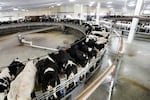
FILE - Cows are milked on a large carousel at a dairy in Pickett, Wis., Dec. 4, 2019. The Oregon Department of Agriculture is working with its neighbors and several other state offices on a plan to respond if a suspected case of avian flu is reported in Oregon dairy cows.
Morry Gash / AP
A handful of dairy cattle herds in at least five states, including Idaho, have tested positive for a strain of bird flu. Oregon Department of Agriculture officials say the agency is working with its neighbors and several other state offices on a plan to respond if a suspected case is reported in Oregon.
On March 25, the U.S. Department of Agriculture confirmed a positive case of highly pathogenic avian influenza, or HPAI, in two dairy herds in Texas and two in Kansas.
A few days later the Idaho Department of Agriculture announced it detected a positive case of the virus in a dairy cattle operation in the southern region of the state. The findings mark the first time HPAI has been detected in dairy cattle, according to the American Veterinary Medical Association.
The same bird flu strain has affected over 80 million poultry birds across the U.S. since 2022, including nearly 800,000 commercial chickens in Oregon. Chickens were so affected in recent years that the virus was blamed in part for skyrocketing egg and meat prices.
Wild migratory birds are believed to be the source of infection for both poultry birds and the recent dairy cattle cases.
Idaho officials said the affected facility recently imported cattle from another state that has identified cases of HPAI in dairy cattle, which suggests the virus may have been transmitted between cows.
While no cases have been reported in Oregon, the state’s department of agriculture is working with the Oregon Department of Fish and Wildlife, Oregon Health Authority and the USDA to update livestock producers and come up with a response plan, according to a statement from the agency.
ODA is also telling producers to practice what it calls good biosecurity, like minimizing dairy livestock movements and isolating sick cows from the herd if they show symptoms like loss of appetite or a drop in milk production.
At least one person in Texas has caught the virus after being exposed to dairy cattle presumed to be infected with the bird flu. Although it usually affects birds, occasionally the virus infects people, though it is extremely rare for it to be transmitted from one person to another, according to the Centers for Disease Control and Prevention. The person in Texas experienced eye inflammation as their only symptom, and the case does not change the risk for the general public, which remains low, according to health officials.
Unlike poultry infections, which are fatal, sick dairy cows tend to recover on their own, according to the USDA. Officials also said it’s still safe to drink milk since it’s pasteurized before being sold, although milk from impacted animals is being diverted or destroyed so that it does not enter the food supply.
